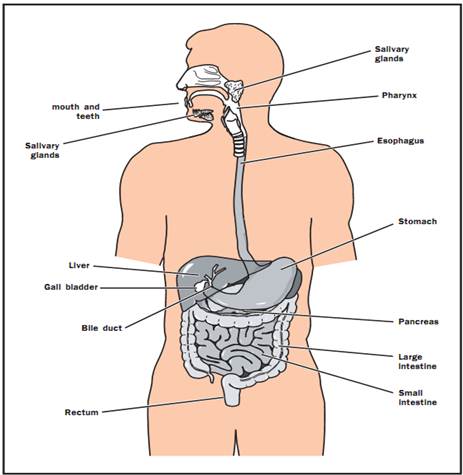Digestive System
The human digestive system is responsible for food ingestion and digestion as well as the absorption of digested food molecules and the elimination of undigested molecules. It consists of a long tube called the gastrointestinal tract or GI tract (alimentary canal) and several accessory organs. The major components of the GI tract are the mouth, pharynx, esophagus, stomach, small intestine, and large intestine. The major accessory organs are the teeth, salivary glands, liver, gallbladder, and pancreas.
Mastication and Swallowing
Ingestion (the intake of food) occurs in the mouth where food is chewed and mixed with saliva. The teeth have different shapes to perform different tasks; the incisors (chisel-shaped anterior teeth) are used to cut into food, the canines (pointed teeth located lateral to the incisors) are used to tear or pierce food, and the premolars and molars (having broad surfaces) are used for crushing and grinding food. Chewing (mastication) of food is accompanied by mixing of the food with saliva. The mouth is normally kept moist by the continual production of small quantities of saliva by numerous tiny intrinsic salivary glands located in the inner lining of the mouth.
During chewing, much greater quantities of saliva are secreted by three pairs of extrinsic salivary glands, namely the parotid glands (located under the skin anterior to each earlobe), the submandibular glands (located under the base of the tongue), and the sublingual glands (located in the floor of the mouth). Saliva is a watery fluid containing several components including lysozyme, an enzyme that kills bacteria, and salivary amylase, an enzyme that begins the digestion of starch.
Once the food has been chewed into a soft, flexible mass called a bolus, it is swallowed for delivery to the stomach. On its journey, the bolus passes through the pharynx and then through the esophagus, a straight muscular tube that descends through the thoracic (chest) cavity, anterior to the spine. Each bolus of food is propelled through the esophagus by gravity, and by the process of peristalsis, a wave of muscular contraction that pushes the bolus downward. The lower end of the esophagus, which passes through a hole in the diaphragm to meet the stomach within the abdominal cavity, has a lower esophageal (or gastroesophageal or cardiac) sphincter which briefly relaxes to allow the bolus of food to enter the stomach.

Parts of the digestive system
Stomach and Intestines
The stomach is a muscular sac that is located in the upper left portion of the abdominal cavity. The inner lining of the stomach wall contains millions of tiny gastric glands that secrete gastric juice, which dissolves the food to form a thick liquid called chyme. Gastric juice contains several substances including hydrochloric acid, intrinsic factor (which is essential for the intestinal absorption of vitamin B
12) and pepsinogen (an inactive protein- digesting enzyme). The hydrochloric acid has several functions including destroying ingested bacteria, and converting pepsinogen into its active form, pepsin, in order to initiate the digestion of protein.
At the lower end of the stomach is the pyloric sphincter, a valve through which chyme must flow to enter the small intestine. Most meals are gradually emptied into the small intestine after two to six hours due to peristaltic contractions that travel toward the lower end of the stomach. Most digestion and absorption occur within the small intestine. The small intestine consists of three segments named the duodenum, jejunum and ileum. The duodenum receives chyme from the stomach as well as pancreatic juice from the pancreas and bile from the liver (and stored in the gallbladder).
Pancreatic juice contains digestive enzymes capable of digesting proteins, carbohydrates, and lipids. Bile emulsifies lipids to increase the efficiency of lipid digestion and absorption. Once digestion has been completed, the digested nutrients are absorbed into blood vessels and lymphatic vessels within the wall of the small intestine.
Peristaltic contractions move chyme through the small intestine and into the large intestine. The large intestine consists of three major segments, the cecum (which receives chyme from the small intestine), the colon, and the rectum. As peristalsis moves chyme through the colon, water is absorbed to gradually convert the chyme into semisolid material called feces. The feces contain indigestible food molecules (primary cellulose) and intestinal bacteria that live in the colon (primarily Escherichia coli). Peristalsis delivers the feces into the rectum where they are stored until they are expelled through the anus by the process of defecation.
References
Saladin, Kenneth S. Anatomy & Physiology: The Unity of Form and Function, 2nd ed. New York: McGraw-Hill, 2001.

















